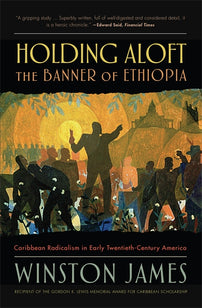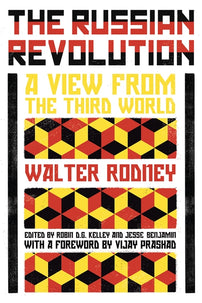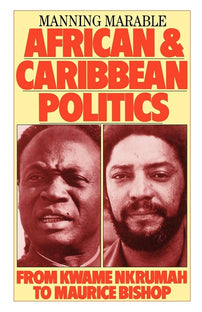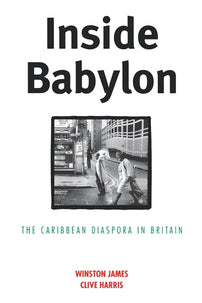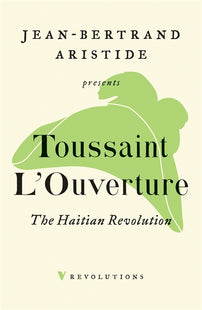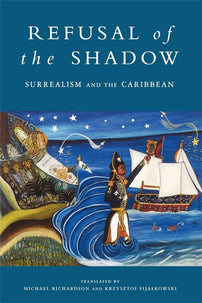Labor and Liberation: An Interview with Margaret Stevens
Historian Margaret Stevens discusses transnational connections between Black radicals during the interwar years, the interplay between militant Caribbean workers’ uprisings and Communist Party leadership, and the lessons of Communist anti-racist and anti-imperialist organizing.

First published at The Public Archive.
A proud product of New Jersey public schools, historian Margaret Stevens went to Newark’s University High School and Rutgers College in New Brunswick before completing her doctoral work in the Department of American Civilization at Brown University. She is the author of the path-breaking study Red International and Black Caribbean: Communists in New York City, Mexico, and the West Indies, 1919-1939, published by Pluto Press. Red International and Black Caribbean is a provocative and deeply researched account of the transnational connections of Black radicals during the turbulent interwar years. It demonstrates the importance of the greater Caribbean to global revolutionary struggle while providing capsule biographies of many un- or lesser-known Black and Brown communists in Haiti, Harlem, Cuba, and Mexico. A contributor to the volume Communist Histories, Volume 1 (LeftWord, 2016), Stevens is Professor in the Department of History at Essex County College in Newark.
Can you say something about the kinds of archives you used and what you found in them? What role did the radical press and journals from Negro Champion to Machete to African Nationalism have in the history you recount?
Well a few basic points. First, even though I made a serious effort to get to and conduct research in as many of the Caribbean regions in this study as possible, I did not make it to all of them. So most of the research comes from DC — the National Archives surveillance reports and the Library of Congress reels. Some material was found in Puerto Rico and Jamaica that was critical, especially Jamaica. But part of the nature of imperialism is such that the archives in Haiti (as I witnessed) and Mexico (as I’ve been told), i.e. less “developed” countries, are way less organized. It is essentially a room full of stacked papers with a vague guide to what is where but nowhere near the organization and differentiation in the US. So it just requires way more time, patience and money — since you have to stay there longer. I’m hoping that for future projects I will be able to dig deeper in such archives.
Second, even though this work focuses on the interplay between militant Caribbean workers’ uprisings and Communist Party leadership, most of the archival work is disproportionately from or about the communist aspect of this dialectic. Communist newspapers and US surveillance archives are where the bulk of the evidence comes from, so there is still so much work to be done to uncover what everyday black workers in and around these movements were thinking, debating and experiencing outside of party circles. This is why the newspapers such as Machete, the Crusader and Emancipator are so important. They allow us — through their correspondence columns — to see what folks were thinking and reporting from a non-party angle.
In terms of what compelled me the most about the American ruling class archives, the first thing that struck me when I began investigating radicalism in the Caribbean was the fact that Naval Intelligence was the most developed and comprehensive archive in the WWI/Post-WWI period in the United States. In other words, when you follow how US imperialism has developed over the past 150 years, you see that it was the Navy in the late 1800s through WWI and into the 1920s that was the strongest arm of the military, so its intelligence was also the strongest. Moving into the 1930s it was the State Department that became the most comprehensive. I’m just surmising here but maybe it is because the consulate offices had been established for long enough by then that they could dig in and get semi-useful information from places like Mexico and Cuba.
With respect to the radical archives from the communist and black radical circles, the newspapers, flyers and meeting minutes were essential to gaining perspective on how the political understanding of communists developed over time and, in turn, was impacted by and also impacted the militant struggles of workers in the Caribbean. But none of these sources alone was sufficient. Here’s an example: The CPUSA’s Negro Champion newspaper might have focused on and promoted the communist movement for the multiracial character of the 1929-1930s protests in NYC to defend Haitian workers, but meeting minutes of the CPUSA would show how divided the leadership within the Negro Department — whose members wrote for the paper — was precisely around what some believed was insufficient internal party support for the antiracist struggle it was waging and supporting in the labor movement. As another example, we know that the “workers correspondence” section of the Negro Worker was often written by editor George Padmore or other party members even when written with the signature of a worker from British Guiana or the French Caribbean. In short, when these newspaper pieces are read less literally and more figuratively, we can see that they represented not only the silencing of colonized voices that these communists were trying to give voice to but also the political imaginary that was demonstrated by these leaders as reflected by the papers. I think many have and continue to cynically dismiss the politics of these papers as shallow, Moscow-directed propaganda.
While you write against the tendency to write the history of Black internationalism as a “tradition” of “great men," emphasizing instead the role of black workers and collective organizations, there are nevertheless a number of individual biographies that are critical to the history you tell. Can you say something about two Haitian Communists who figure prominently in the book? The first, Henri Rosemond, isn’t well known; the second, Jacques Roumain, is, though largely as a novelist, not an activist. Who were they? And what was the political and historical significance of the organizations?
Henri Rosemund and Jacques Roumain make my case perfectly about the importance of organization history with respect to antiracism in the 20th century precisely because both of their political significance stems most notably from the fact that they were part of the origination of the Haitian Communist Party in 1930. Sadly, I have very little information about the early Haitian Communist Party. Matthew Smith, a colleague I met in Jamaica some years back, actually wrote a whole book on Haiti and the left, though as I recall it was not based on the 1930s for the most part. Henri Rosemund for me is so fascinating for several reasons. He is a classic example of the reciprocity of radicalism between the Caribbean and NYC — the back and forth — that my book posits. He seems to have arrived as an immigrant worker into NYC where he was part of the Haiti Patriotic League, a non-Comintern affiliated nationalist group. From there, he seems to have been intrigued by and recruited into the Anti-Imperialist League, one of the Comintern mass organizations featured in this book, and from there, he seems to have joined the CPUSA and the American Negro Labor Congress. It was Rosemund who was clubbed and nearly beaten to death in NYC in early 1929 — months before the “Haitian Revolution” that year which was sparked by radical Haitian students at the Damien School on the island who were upset with how the US occupation allowed for American overlordship in the educational system. When Rosemund was beaten, he was essentially part of leading thousands of workers in the needle trades (aka garment) industry in NYC to fight for better working conditions and rights, and that a black man took such a leading role in what would have been a fight largely geared toward immigrant eastern European workers was without a doubt pioneering for its time or even today. After recovering from his near-death experience, and despite feeling like the CPUSA could have done more to assist him personally in his recovery, he returned to organizing and by early 1930 had gone to Haiti to help develop and Anti-Imperialist League chapter there in the wake of President Hoover’s visit to the island. In two years, Rosemund did more for the international workers’ movement than many people then or today accomplish in a lifetime. And yet Toussaint is the only name many people know with respect to Haitian revolutionary history.
How did the Communist Party respond to the US occupation of Haiti and to the 1929 protests that eventually led to the occupation’s end?
The CPUSA called the 1929 protests the “Haitian Revolution.” That is, it invoked the most revolutionary anticolonial revolt of the nineteenth century as a means of conveying the significance of workers’ militancy in Haiti in the 1920s. And it placed this uprising alongside the victories underway in Soviet Russia and Communist China in the contemporary period. Rose Pastor Stokes of the CPUSA indirectly gave her life in defense of Haiti’s 1929 uprising in that she was clubbed in the head by police which later led to long-term brain injuries as a protest in NYC while defending Haitian workers. So people in the US physically gave their lives for the cause. Even more, the CPUSA supported the founding of a party in Haiti, as mentioned above in the case of Henri Rosemund.
You write of Cuba’s Oriente province as the country’s “Black Belt,” the latter term suggesting a link to the CP’s “Black Belt Thesis.” What is the nature of this link?
Yes, I don’t think I’m the first to point to this connection, but it plays a pretty major role in my book. The main point that I was trying to make about Cuba’s Black Belt thesis, and this is precisely what it was, is that its application was in many ways more revolutionary than that which emerged in the southern United States. In the early 1930s, the Cuban political scene was extremely unstable, characterized on one hand by divisions within the island’s ruling elite all vying for degrees of power in collusion with or against the US — depending on economic interest — and on the other hand the working class was extremely militant, almost to the point that the Cuban Communist Party could potentially have seized political and economic power in small portions of the island. Indeed, in the Black Belt of Cuba, which is a reference to Oriente province, there were several instances wherein the sugar workers actually seized hold of the estates if only for a time. I even came across talk of Jamaican “red guards” preventing bosses from entering their own property which had been seized by militant workers. The communists were all part of this militant direct action in Cuba, though to a significant degree they were not fully enough in charge as communists per se but more so as radical labor leaders.
That is the internal situation within Cuba, but from the hemispheric and then global angle, the CPUSA and CCP (Cuban Communist Party) were in what appears to have been pretty frequent touch. Indeed the CPUSA had been assigned Cuba by Moscow as one of the hemispheric locales that it was responsible for helping to direct politically. Since much of the most militant and anti-racist action was actually emanating from Cuba more so than the United States, many members of the CPUSA found themselves in Cuba throughout the 1930s in support of the radicalism there and also to help bring issues like the Scottsboro Boys to light on the island. By 1934, the “Black Belt Thesis” was not only a major aspect of the CPUSA strategy toward waging antiracist struggle in the United States but at the same time black working class militancy was at its peak in Cuba’s “Black Belt.” So communist organizers like Henry Ford and Henry Shepard who went from Harlem to Cuba that year did so to help forge labor solidarity among union workers in the US and Cuba and also to show that multiracial unity was necessary for fighting racism and gaining workers power. In turn, Cuban workers across the island had banners and protests to defend the Scottsboro Boys campaign based out of the US. In this way, as this book constantly points out, the interwar period of radicalism was much more transnational and reciprocal than most people acknowledge, and black workers were always critical to this process.
While the book focuses on what you term the “Black Caribbean,” you also engage the “Brown Caribbean” through your discussion of the Indian populations of Trinidad and British Guiana — and, surprisingly, through the role of Mexico in regional organizing. What is the significance of Mexico for your story? And what does Red International, Black Caribbean teach us about solidarity across Black and Brown racial lines?
Thank you for this question. It is such an important one. The significance of Mexico for this work is still emerging. Much more remains to be seen about just how deeply embedded the Mexican communists were in the radical networks across the Caribbean where black workers were predominant. Of what I have uncovered, the place of Mexico has two important functions in our historical understanding of the period. First, it was a place of refuge for not only radicals like the forced emigre from Republican Spain, but also for black revolutionaries like Jacques Roumain who spent some time there after being released from prison in Haiti and a short stint in Europe. Second, Mexico was the first people of color Communist nucleus in the western hemisphere, and the sense of anti-imperialism and sensitivity to chauvinism in the CPUSA was critical to strengthening the anti-racist struggle across the region.
You both begin and end Red International, Black Caribbean by suggesting that the history of Communist anti-racist and anti-imperialist organizing offers lessons for the present, even if mistakes were made in the past. In your view, what are some of these lessons?
First, black workers cannot successfully fight racism alone. Black working class militancy is THE essential precondition for the fight against racism, but it is not sufficient. Integrated efforts with the support of white radical workers and political activists is necessary as well. Second, militancy from colonized workers and workers at the periphery of finance capital are still THE essential preconditions for destabilizing imperialism, but they cannot do this without the international support of radical and militant workers in more economically advanced regions of the world.
Let’s take the recent situation in Puerto Rico with Hurricane Maria. While the island was already suffering from over a century of super-exploitation at the hands of US industrialists, pharmaceuticals, and the military, it would be absolutely naive to think that Puerto Rican workers alone can successfully take on the US imperial machine. The book showed that there has always been a pendulum swing effect for imperialism. The 1929 crash on Wall Street, which was anticipated by smaller crashes across the Caribbean where US imperialists were based was followed by even more intense attacks on workers in these same peripheral regions of finance capital. In a similar way the 2008 housing crisis in the US was precipitated by smaller crashes like in the Puerto Rican economy in 2006, and it was echoed even more severely in the aftermath of the US domestic crash. Student led mass strikes in the mid-2000s in Puerto Rico led to larger working class strikes which, leading up to and after Maria, have resulted in tens of thousands of workers protesting at May Day and militantly taking on the local elites and US bank industry. But this militancy alone, coupled with calls for independence, would never be enough to liberate Puerto Rican workers from this system of oppression. Deep seated, deliberate and long-term strategic alliances between US and Puerto Rican workers through organizational infrastructure are still the necessary foundation for lasting workers’ empowerment in both regions. This is something that the book demonstrates to some extent but that today’s radical movements can demonstrate even more powerfully.
[book-strip index="1" style="display"]